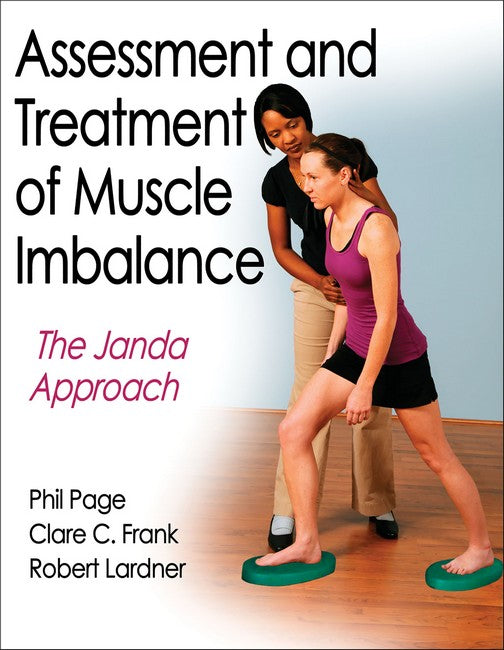Phil Page, MS, PT, ATC, CSCS, trained under the guidance of Dr. Vladimir Janda and has taught the Janda approach at national and international workshops. A certified kinesiotaping practitioner, Page is currently working toward his doctorate in kinesiology at Louisiana State University in Baton Rouge, where his research focuses on EMG and muscle imbalance. He is also director of clinical education and research for Thera-Band products. Page and his wife, Angela, live in Baton Rouge with their four children. In his free time, he enjoys spending time with his family, fishing, and cooking. Clare C. Frank, DPT, is an orthopedic clinical specialist in private practice in Los Angeles. She serves on the clinical faculty for Kaiser Permanente Movement Science Fellowship in Los Angeles. She also serves as a guest lecturer at the local universities and teaches throughout the United States and internationally. Frank studied under and taught with Dr. Vladimir Janda. She is a certified instructor of the Janda approach to musculoskeletal pain syndromes, a certified kinesiotaping practitioner, and a certified instructor of Kolar's approach to dynamic neuromuscular stabilization. Frank is board certified in orthopedic physical therapy and a fellow of the American Academy of Orthopedic Manual Physical Therapy. Robert Lardner, PT, was born in Nigeria in 1961. His first career was as a professional ballet and modern dancer after studying at the Rambert Academy outside London, England. He graduated from the department of physical therapy, Lund's University, Sweden in 1991. He studied with Professors Janda, Lewit and Kolar from the Czech Republic, who are pioneers of functional rehabilitation and manual medicine. Lardner worked in several inpatient and outpatient rehabilitation facilities in Sweden prior to moving to the United States in 1992. He was a staff physical therapist at McNeal Hospital, Clearing Industrial Clinic, and a physical therapy supervisor at Mercy Hospital. He also was in charge of physical therapy services at a number of private outpatient and sports clinics. Lardner is currently in private practice in Chicago and teaches various rehabilitation seminars throughout the United States and Europe.
Request Academic Copy
Please copy the ISBN for submitting review copy form
Description
Part I. The Scientific Basis of Muscle Imbalance Chapter 1. Structural and Functional Approaches to Muscle Imbalance Intrinsic Versus Extrinsic Fuction Muscle Balance in Function and Pathology Muscle Imbalance Paradigms Summary Chapter 2. The Sensorimotor System Sensorimotor Hardware and Software Neuromuscular Aspects of Postural Stability and Joint Stabilization Pathology in Proprioception Summary Chapter 3. Chain Reactions Articular Chains Muscular Chains Neurological Chains Summary Chapter 4. Pathomechanics of Musculoskeletal Pain and Muscle Imbalance Pathology of Musculoskeletal Pain Pathomechanics of Muscular Imbalance Causes of Muscle Tightness and Weakness Janda's Classification of Muscle Imbalance Patterns Summary Part II. Functional Evaluation of Muscle Imbalance Chapter 5. Posture, Balance, and Gait Analysis Muscle Analysis of Standing Posture Evaluation of Balance Evaluation of Gait Summary Chapter 6. Evaluation of Movement Patterns Janda's Basic Movement Patterns Additional Movement Tests Complementary to Janda's Tests Selected Manual Muscle Tests Summary Chapter 7. Muscle Length Testing Muscle Length Assessment Technique Lower-Quarter Muscles Upper-Quarter Muscles Hypermobility Summary Chapter 8. Soft-Tissue Assessment Characteristics of Trigger Points Assessment of Trigger Point or Tender Point Chains Scars Myofascia Summary Part III. Treatment of Muscle Imbalance Syndromes Chapter 9. Normalization of Peripheral Structures Central Indirect techniques Local Direct techniques Summary Chapter 10. Restoration of Muscle Balance Factors Contributing to Muscle Weakness Additional Treatment Techniques for Muscle Weakness Factors Contributing to Muscle Tightness Additional Treatment Techniques for Muscle Tightness Summary Chapter 11. Sensorimotor Training Role of Sensorimotor Training in Janda's Treatment Sensorimotor Training Components Sensorimotor Training Progression Summary Part IV. Clinical Syndromes Chapter 12. Cervical Pain Syndromes Regional Considerations Common Pathologies Case Study Summary Chapter 13. Upper-Extremity Pain Syndromes Regional Considerations Assessment Common Pathologies Case Study Summary Chapter 14. Lumbar Pain Syndromes Regional Considerations Common Pathologies Sacroiliac Dysfunction Assessment Management of Low Back Pain Syndromes Case Study Conclusion Summary Chapter 15. Lower-Extremity Pain Syndromes Regional Considerations Assessment Common Pathologies Case Study Summary
"A practical text for clinicians treating patients with musculoskeletal complaints." SciTech Book News (March 2010) "An excellent book and a fitting tribute to Janda - well done! I attended several of Janda's courses in the UK over a period of many years and his influence on my professional life was significant." Christopher Norris, PhD, MSc, MCSP, MBAcC -- Director of Norris Associates "This would make a useful addition to every clinician's library-especially physical therapists, chiropractors, osteopaths, and all those using hands-on therapies." Journal of Bodywork and Movement Therapies "...a thorough, well-organized, and well-written summary of the Janda approach to muscle imbalance." Journal of Orthopedic and Sports Physical Therapy "With its modest price tag and practical insights of both assessment and treatment of muscle imbalance, I would recommend this book to any practitioner or student planning to treat MSK disorders." Manual Therapy This book "provides a lot of useful information that is different from the typical treatment approaches taught in most physical therapy schools and it can only help give clinicians insights that may help them treat their patients." Orthopedic Physical Therapy Practice

